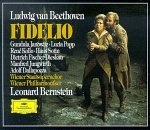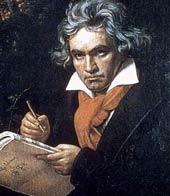
Fidelio, unsuccessful at its premiere, was twice revised by Beethoven and his librettists and successful in its final version of 1814. Here there is more emphasis on the moral force of the story. It deals not only with freedom and justice, and heroism, but also with married love, and in the character of the heroine Leonore, Beethoven's lofty, idealized image of womanhood is to be seen. He did not find it in real life he fell in love several times, usually with aristocratic pupils (some of them married), and each time was either rejected or saw that the woman did not match his ideals. In 1812, however, he wrote a passionate love-letter to an 'Eternally Beloved' (probably Antonie Brentano, a Viennese married to a Frankfurt businessman), but probably the letter was never sent.
With his powerful and expansive middle-period works, which include the Pastoral Symphony (no.6, conjuring up his feelings about the countryside, which he loved), Symphony no.7 and Symphony no. 8, Piano Concertos nos.4 (a lyrical work) and 5 (the noble and brilliant Emperor) and the Violin Concerto, as well as more chamber works and piano sonatas (such as the Waldstein and the Appassionata) Beethoven was firmly established as the greatest composer of his time. His piano-playing career had finished in 1808 (a charity appearance in 1814 was a disaster because of his deafness). That year he had considered leaving Vienna for a secure post in Germany, but three Viennese noblemen had banded together to provide him with a steady income and he remained there, although the plan foundered in the ensuing Napoleonic wars in which his patrons suffered and the value of Austrian money declined.
The years after 1812 were relatively unproductive. He seems to have been seriously depressed, by his deafness and the resulting isolation, by the failure of his marital hopes and (from 1815) by anxieties over the custodianship of the son of his late brother, which involved him in legal actions. But he came out of these trials to write his profoundest music, which surely reflects something of what he had been through. There are seven piano sonatas in this, his 'late period', including the turbulent Hammerklavier op.106, with its dynamic writing and its harsh, rebarbative fugue, and op.110, which also has fugues and much eccentric writing at the instrument's extremes of compass; there is a great Mass and a Choral Symphony, no.9 in d Minor, where the extended variation-finale is a setting for soloists and chorus of Schiller's Ode an die Freude (Ode to Joy); and there is a group of string quartets, music on a new plane of spiritual depth, with their exalted ideas, abrupt contrasts and emotional intensity. The traditional four-movement scheme and conventional forms are discarded in favour of designs of six or seven movements, some fugal, some akin to variations (these forms especially attracted him in his late years), some song-like, some martial, one even like a chorale prelude. For Beethoven, the act of composition had always been a struggle, as the tortuous scrawls of his sketchbooks show; in these late works the sense of agonizing effort is a part of the music.
 Musical taste in Vienna had changed during the first decades of the 19th century; the public were chiefly interested in light Italian opera (especially Rossini) and easygoing chamber music and songs, to suit the prevalent bourgeois taste. Yet the Viennese were conscious of Beethoven's greatness: they applauded the Choral Symphony even though, understandably, they found it difficuit, and though baffled by the late quartets they sensed their extraordinary visionary qualities. His reputation went far beyond Vienna: the late Mass was first heard in St. Petersburg, and the initial commission that produced the Choral Symphony had come from the Philharmonic Society of London. When, early in 1827, he died, 10,000 are said to have attended the funeral. He had become a public figure, as no composer had done before. Unlike composers of the preceding generation, he had never been a purveyor of music to the nobility he had lived into the age - indeed helped create it - of the artist as hero and the property of mankind at large.
Musical taste in Vienna had changed during the first decades of the 19th century; the public were chiefly interested in light Italian opera (especially Rossini) and easygoing chamber music and songs, to suit the prevalent bourgeois taste. Yet the Viennese were conscious of Beethoven's greatness: they applauded the Choral Symphony even though, understandably, they found it difficuit, and though baffled by the late quartets they sensed their extraordinary visionary qualities. His reputation went far beyond Vienna: the late Mass was first heard in St. Petersburg, and the initial commission that produced the Choral Symphony had come from the Philharmonic Society of London. When, early in 1827, he died, 10,000 are said to have attended the funeral. He had become a public figure, as no composer had done before. Unlike composers of the preceding generation, he had never been a purveyor of music to the nobility he had lived into the age - indeed helped create it - of the artist as hero and the property of mankind at large.

|









